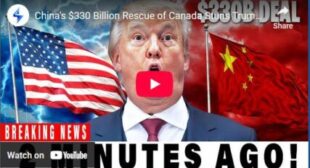
This realignment threatens U.S. economic influence as American businesses—particularly in tech, automotive, agriculture, and energy—face shrinking markets in China. Companies like Apple, General Motors, and Nike, heavily reliant on Chinese consumers, risk substantial losses, while farmers grapple with oversupply and crashing prices due to China’s shift to suppliers like Brazil.
Canada, countering U.S. tariffs, has deepened energy ties with China through projects like the Trans Mountain pipeline and a major LNG terminal set for 2025, reducing reliance on U.S. markets. Meanwhile, China’s diplomatic outreach to Europe positions it as a stable trade partner, potentially sidelining the U.S.
The tariffs have raised costs for American consumers, with industries like steel and retail facing price hikes, while rebuilding U.S. manufacturing proves challenging due to high labor costs and lacking infrastructure.
As inflation looms and the Federal Reserve faces tough choices, the U.S. risks losing its global trade dominance. This evolving economic battle underscores the need for a smarter U.S. trade strategy to avoid being marginalized in a rapidly shifting global order.
